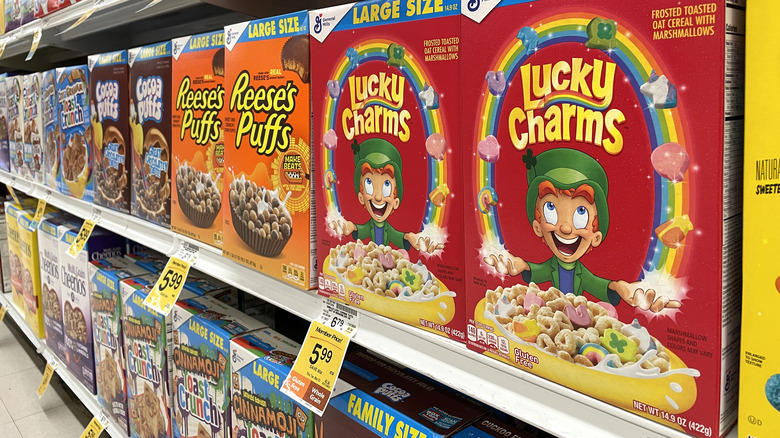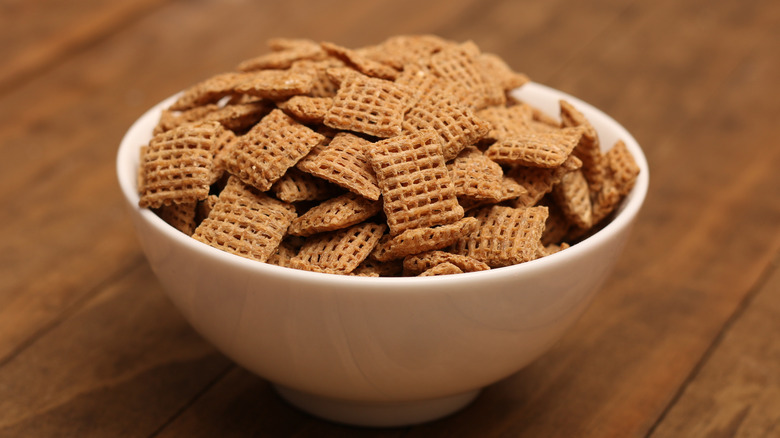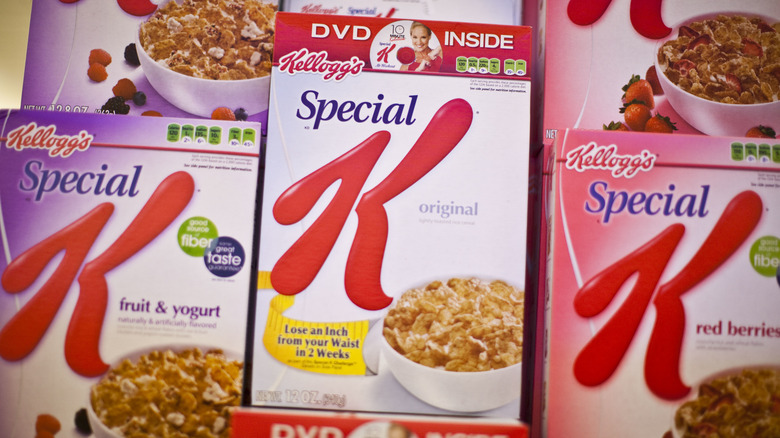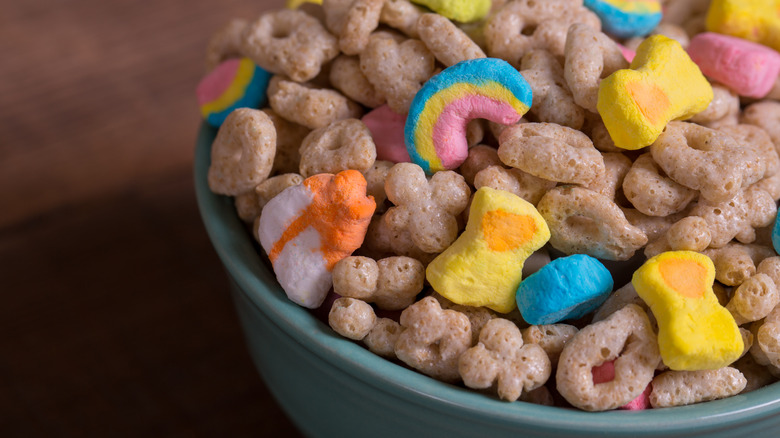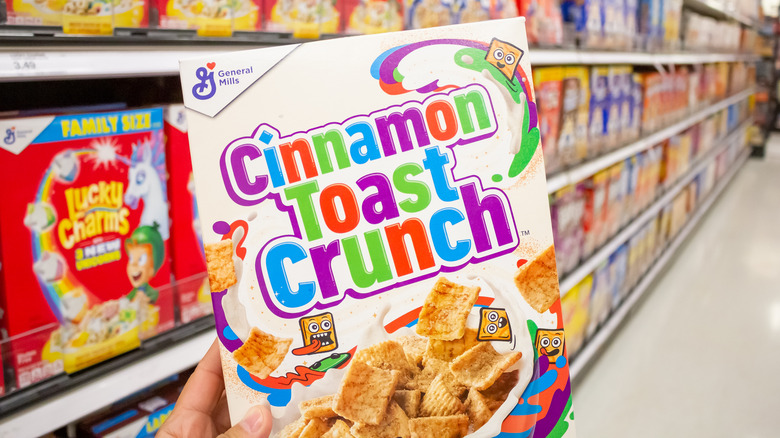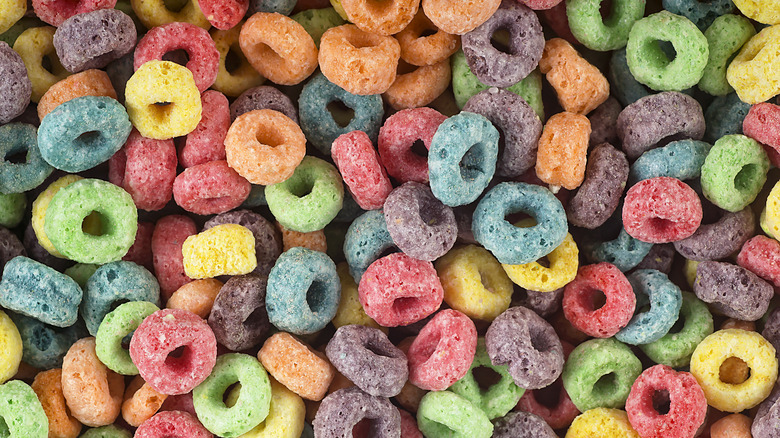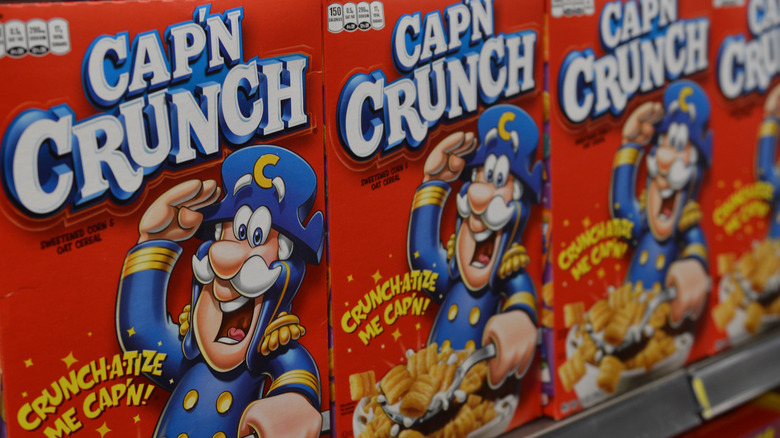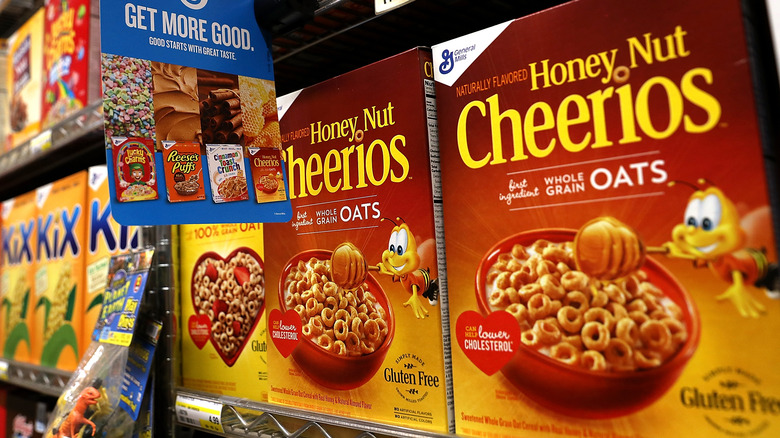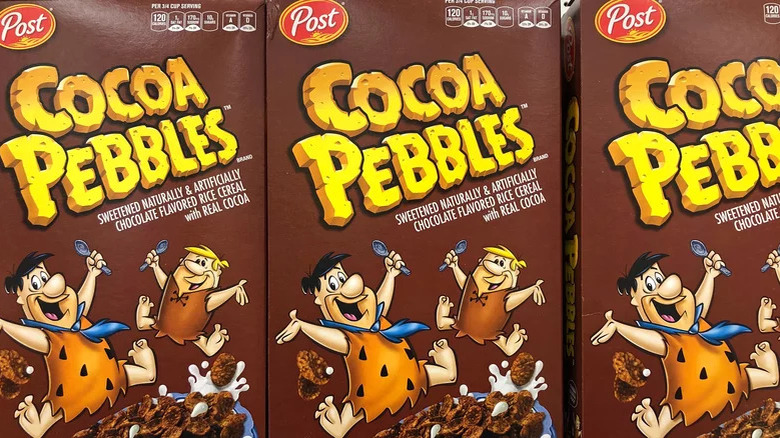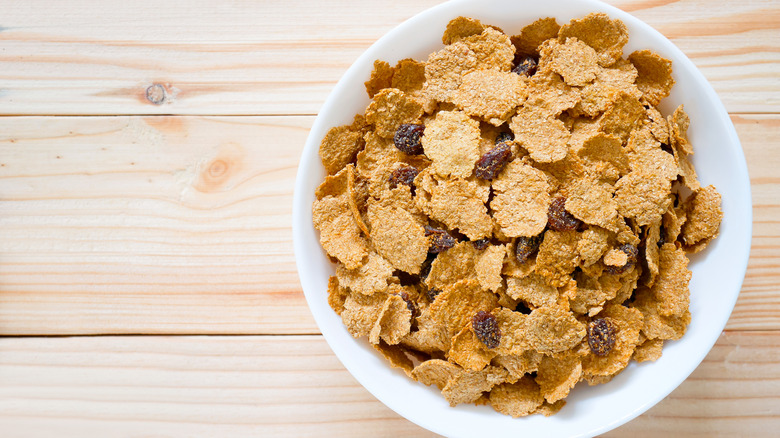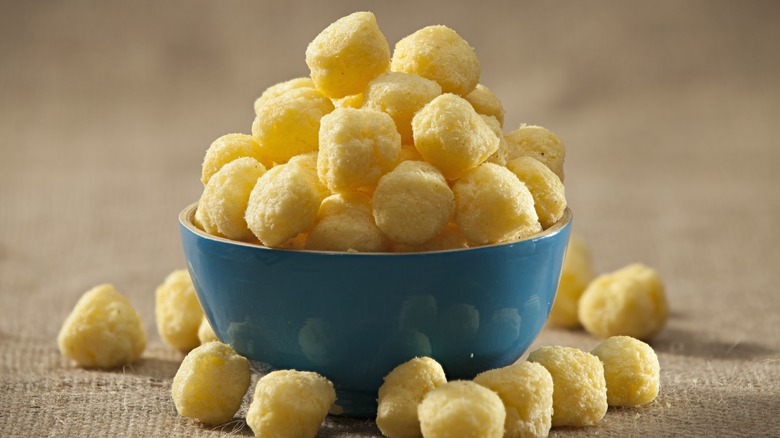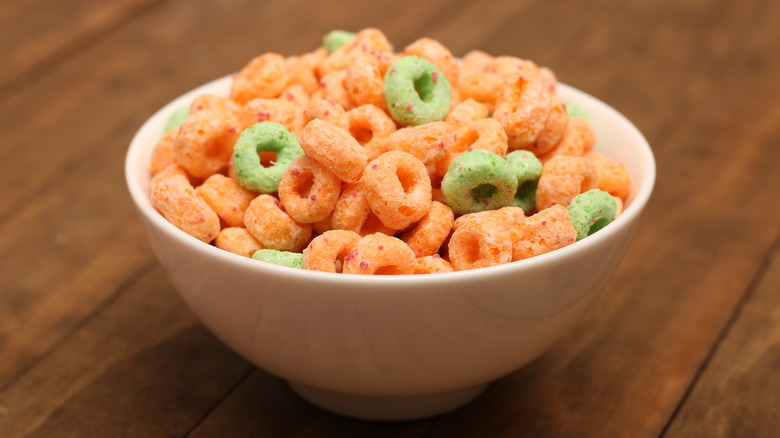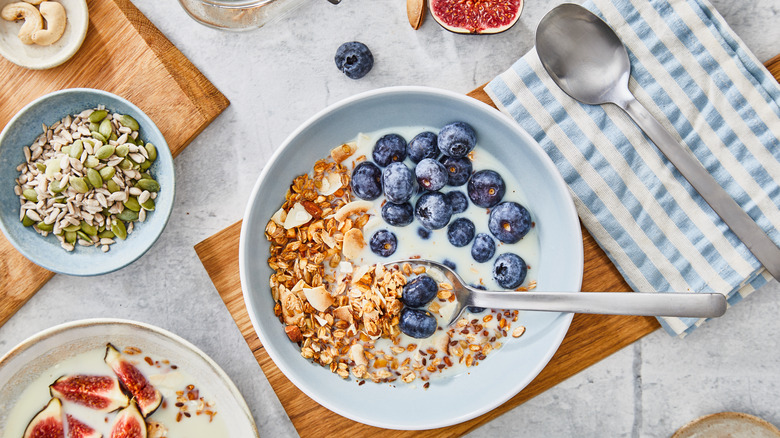11 Unhealthiest Cereals You Can Buy
It's one of the most commonly eaten breakfasts across the states for good reason. Loved by morning go-getters and midnight snackers alike, cereal is the social chameleon of foods. It's quick, it's efficient, it's tasty. Despite its good merits, cereal isn't immune to bad press. The real reason Mr Kellogg invented cereal in 1895 was to create a health food. But since then, there's been a shift. Bowls of unsweetened Kellogg's have been replaced with chocolate-flavored, yogurt-coated, sugar-dusted breakfasts.
So what's the issue? Registered dietitian, Charlotte Furman, told The Whole U that she'd limit processed cereals "...which contain a lot of added sugars and little nutritional value." Instead, she puts emphasis on protein and fiber, which will make you fuller for longer. And here's the thing, there are lots of cereals out there which are much better for you. The cereals you should be eating are full of fiber, protein, and whole grains, and are low in salt and sugar. But when the craving for a bowl of kid's cereal hits, an omelet isn't going to cut it. So if you are reaching for the box, here are the unhealthiest ones to leave on the shelf.
1. Wheat Chex
The Chex website boldly claims that "Wheat Chex Cereal is always wonderful," and we don't doubt that it is a delicious cereal. But what isn't so wonderful is the whopping 340 mg of sodium per cup (the recommended serving size) of Wheat Chex. The Dietary Guidelines for Americans say that adults should keep sodium consumption below 2,300 mg per day, less for those under 14 years old. So a quick, "healthy" breakfast of Wheat Chex could actually account for almost 15% of your daily sodium intake in one swoop — and that percentage is higher if you're giving them to the kids.
At the moment, most Americans are eating far higher levels of sodium than is recommended. According to the CDC, the average citizen will consume 1,100 mg more sodium a day than what the guidelines suggest, which is bad news for your heart. Too much of the stuff can result in raised blood pressure and, thus, raised chances of heart attacks and strokes. Whilst we do love the inventive idea on the website of "...sprinkling crushed Wheat Chex atop hummus for more texture alongside your favorite veggies," make sure you are keeping an eye on your salt intake if you are opting for the Chex.
2. Special K
Didn't expect to see this one on the list, did you? Despite its history with health nut Mr Kellogg, who is dubbed as the "original wellbeing visionary" on the Kellogg's website because of his aspirations to make Corn Flakes the ultimate health food, and its diet culture connotations (it even had a whole diet named after it), Special K isn't all it's cracked up to be. Its fiber content is negligible, at under 1 g per serving, and it packs a substantial 270 mg of sodium per 1¼ cup serving. Plus, there aren't enough other nutrients knocking around in that box to make up a balanced diet, so if you were tempted to try the retro cereal-only trend, you'd be missing out on tonnes of vital nutrients that won't make you feel good in the long run. Actually, Special K is one of those cereals you should be avoiding.
And whilst we'd usually agree that if something is good enough for royalty then, by golly, it's good enough for us, too. However, in this case, we're going to have to disagree with the late Queen of England. Though Her Majesty Queen Elizabeth II might have been partial to a bowl of the stuff for breakfast, it's just not going to fuel you for a good day's work, whether that's ruling a nation or going to your 9 to 5.
3. Lucky Charms
Unlike Special K, if you're tucking into a bowl of Lucky Charms, you're most likely under no illusions that you're tucking into a "health" food. Maybe it's the marshmallows, maybe it's the frosted cereal, maybe it's the alarming color the milk turns after the cereal has had a bath in it...Or maybe it's the concerning fact that the FDA had to investigate Lucky Charms over poisoning allegations. Yep, Lucky Charms is boldly, brazenly its additive-filled self.
But under that cheerful glaze, what's so unhealthy about them? Twelve grams of sugar and 220 mg of sodium per the recommended 1 cup serving is what. The sodium content is just under 10% of an adult's intake and the sugar intake is even more significant. According to the American Heart Association, men should be eating 36 g of sugar per day, and for women, it's slightly less at 25 g. That 12 g of sugar in your morning bowl will clock up 33% of the recommended intake for men, and an even more impressive 48% for women. They may taste delicious, but that's a breakfast that will set you up for an imminent sugar crash.
4. Cinnamon Toast Crunch
Cinnamon is an incredible spice. It's warming, full of natural flavor, and surprisingly nutritious. In fact, it has been argued that you should eat cinnamon every day because of its potent health benefits. However, that's not necessarily the case when you are consuming cinnamon in the form of Cinnamon Toast Crunch.
Cinnamon is listed pretty far down in the recipe; it comes ninth after some less desirable ingredients like sugar, canola oil, fructose, dextrose, and salt. So, sadly, in the case of this cereal, the health benefits of cinnamon get overridden by the high salt, sugar, and calories per recommended serving. Though we appreciate the website stating that "...Parents like that each crispy square is made with whole grain wheat, and without high fructose corn syrup or artificial flavors," what we don't appreciate as much is the healthy dose of sugar (12 g), sodium (230 mg), and a calorie count that is one of the highest in this list (170 calories) in each one-cup serving.
5. Froot Loops
Just because they've got '"froot" in the name, you shouldn't be fooled. Kellogg's Froot Loops don't count as one of your five a day. A measly 2 g of fiber, 12 g of sugar, and 210 mg of sodium in each serving of 1 ⅓ cup ensure that they're actually one of the unhealthiest cereals you can buy. Despite their nostalgia and temptingly cheerful colors, you should really avoid having Froot Loops for breakfast. Why? Well, according to Spoon University sugar makes up an astonishing 44% of the weight of those little O's.
It's no secret that Americans like to eat sweets for breakfast, but what's the big deal with so much sugar? According to heath.com, it can actually make you crave more sugar, can speed up the aging process, and will contribute to chronic diseases like diabetes. Plus, that blood sugar spike will soon have you crashing into a shaky, mid-morning mess, and grasping for a snack to hold you over until lunchtime.
6. Cap'n Crunch
Cap'n Crunch may be, as the website cheerily states, sweet and golden, and it may have a crunch we love, but there are a few things we don't love about this cereal. It's got a real sugar hit packed in (a total of 17 g per 1 cup serving) and that, paired with less than 1 g of fiber, makes it the perfect recipe for hunger pangs pretty soon after you've washed up the bowl.
The smack of sugar will cause a spike and then crash, and the lack of fiber means you'll be left feeling pretty unsatisfied. Ultimately, you'll be rooting around in the cupboards for something to fill the void in your stomach much sooner than if you'd had a nutrient-dense, protein-packed breakfast.
If you simply can't resist the call of the Cap'n, here's a trick to make the meal a bit more satiating: You should never eat dry cereal alone for breakfast. Add some fiber in the form of nut butters, fruit, or even a slice of whole-grain toast on the side. It might sound counterintuitive, but by eating a bit more at breakfast alongside your bowl of golden balls, you'll likely eat less later in the day.
7. Honey Nut Cheerios
There is something very nostalgic about a big bowl of cereal, and one of the most nostalgic of all cereals has got to be Honey Nut Cheerios. The rattle of that famous red and yellow box was, and is, the soundtrack to many an American's morning. And because "honey" and "nut" are in the title, you'd be forgiven for thinking that this is a relatively healthy product. You'll be even more misled when reading the product description on the website. It claims the cereal to be "heart healthy," promises each spoonful to contain real honey, almonds, no artificial colors or preservatives, and has just under half of the recommended 48 g of whole grain per day in each cup serving.
And, ok, they're technically telling the truth, but just like your favorite influencer, they're only showing the highlight reels. In fact, one bowl of Honey Nut Cheerios has almost 10% of your daily recommended intake of sodium and is the equivalent of about one tablespoon of sugar, which suddenly sounds a little less wholesome than what the label would have you believe. We hate to break it to you, but it's one of those breakfast cereals you can't pretend are healthy anymore.
8. Cocoa Pebbles
One online reviewer put it well when they said, "They are not super filling, but I absolutely love them. Health-wise they are your basic sugary cereal. Nothing too terrible, but also not the healthy option." And they've got it pretty accurate. The reason the reviewer didn't feel full after a bowl of Cocoa Pebbles is because of that magic hunger-making combo of low fiber (less than 1 g per cup serving) and high sugar (12 g).
Despite the fact that Cocoa Pebbles have been delighting the breakfast table of Americans for half a century, in that time they've not done much to healthify those chocolatey balls. But if chocolate is what you want first thing in the morning, then it's hard to opt for something like poached eggs and avocado. If chocolate is what you want, try out this no-bake chocolate oatmeal recipe. Banana, oats, chia seeds, cocoa powder, maple syrup, cinnamon, walnuts, almond milk, strawberries, and chocolate chips will give you a sweet, chocolate hit but the fruits, seeds, and nuts will make sure you're fuelled much longer than you would with a bowl of Cocoa Pebbles in the tank.
Let's circle back to the Cocoa Pebbles reviewer, who finished their paragraph with a nice sentiment, "... they'll just be an occasional treat for my own kids, but that's partly because I'm hiding them from the kids so I can eat them...". We like your style, online reviewer. Everything in moderation.
9. Raisin Bran Cereal
Both raisins and bran are excellent sources of fiber, and considering this list is especially concerned with levels of that lovely nutrient, it's surprising to see Raisin Bran Cereal cropping up here, isn't it? Let us explain because it is true that a bowl of the stuff will give you a hefty 9 g of fiber (which accounts for around 35% of the recommended daily intake) in each 1 ¼ cup serving, but there's more going on in that bowl than meets the eye.
One bowl contains a whopping 20 g of sugar, 240 mg of sodium and is the highest in calories out of all these cereals at 190 cal per recommended serving. For context, the sugar content alone is 80% of the average woman's intake. That leaves you with approximately 1 teaspoon of sugar left for the day. So go for it if you want, but we'd recommend keeping an eye on your sugar intake for the rest of the day, and maybe find some ways to up the sweetness without adding sugar to see you through the rest of the day.
10. Corn Pops
On the surface, Corn Pops are hard to dislike. Those sweetened puffs of crunchy corn are a simple, unfussy way to start the day if you're not after anything too marshmallow-studded or chocolate-coated. But just because they are free from frills doesn't mean they are free from sugar or sodium. One 1 ⅓ cup serving will give you 15 g and 160 mg, respectively, and no fiber at all.
Our issue with Corn Pops is that, if you're after the simplicity they'll give you, you're much better off opting for something like the Arrowhead Mills whole grain puffed cereal. There is only one ingredient in this bag (puffed corn) which means that you'll keep the sugar and sodium levels at zero and there's an added bonus of 2 g of fiber in the bowl. But if you do want to add a little bit of sweetness to the bowl then you're in charge. Add a drizzle of honey, some berries, and maybe take things one step further and make some peanut butter milk for an added protein boost. Suddenly you've got a bowl of grown-up, satisfying Corn Pops that will become your new favorite, healthy breakfast.
11. Apple Jacks
A bowl of Kellogg's Apple Jacks might deliver you "apple cinnalicious fun" in every spoonful, but it'll also deliver you a whopping dose of sugar and sodium, which, if you ask us, is a bit less fun. Despite the fruity name, Apple Jacks are another cereal that wants to trick you into thinking it's healthier than it actually is.
Though it might be true that a bowl contains a trio of different whole grains, there's much more to the ingredients list. Sugar, for example, is the second ingredient on the box. So whilst each 1 ⅓ cup might give you around 7% of your fiber intake for the day thanks to those whole grains, they'll also have you bouncing off the walls from a 13 g dose of sugar. We're not sure that qualifies them as being, as the website describes, a "...delicious part of any balanced breakfast."
Apple and cinnamon make for a cozy breakfast, and if that comforting flavor combination is what you crave when you wake up, try this easy spiced apple overnight oats recipe instead. Unlike Apple Jacks, this one will actually count towards one of your five a day and can be prepared the night before, so all you'll have to do in the morning is take your breakfast out of the fridge and grab a spoon. That's just as easy as pouring out a portion of Apple Jacks and your body will thank you for all the additional nutrients.
Methodology
To come up with the 11 unhealthiest cereals you can buy, we took into account elements that nutritionists see as being especially beneficial or negative to eat for breakfast. High sodium and high sugar content, as well as low fiber content were especially common nutrients to take into account.
We compared the calories, fiber, sugar, and sodium levels in each serving of the most popular cereals, according to Food and Wine. Those with very high levels of sodium, sugar, or calories, and low levels of fiber were selected.
